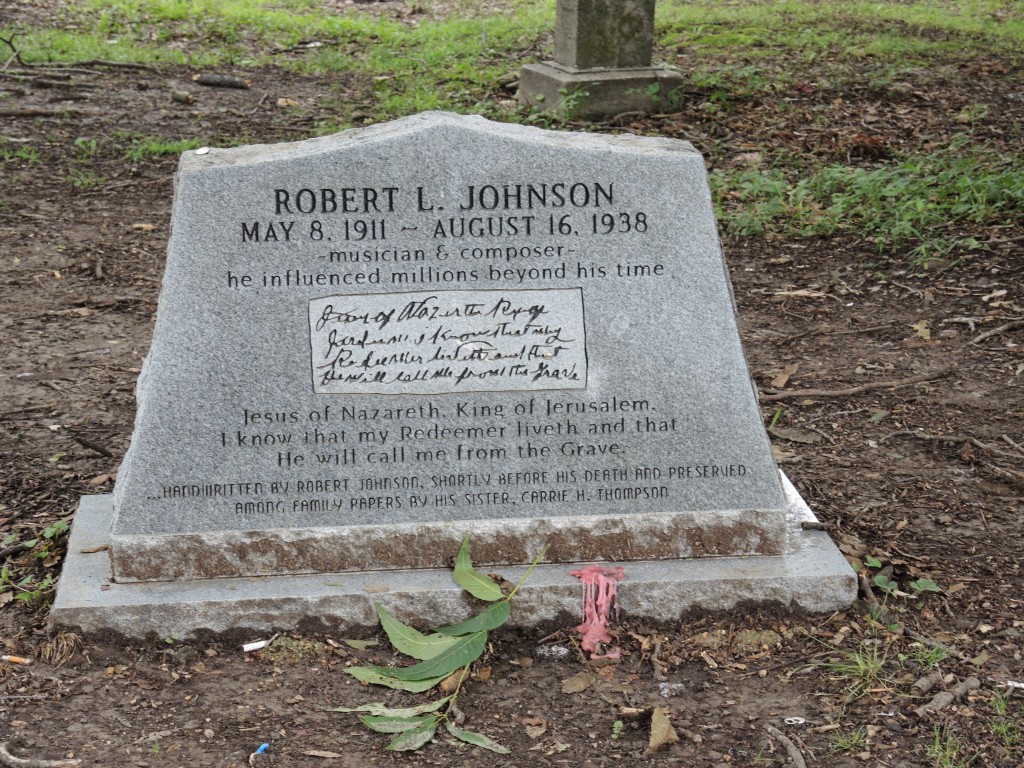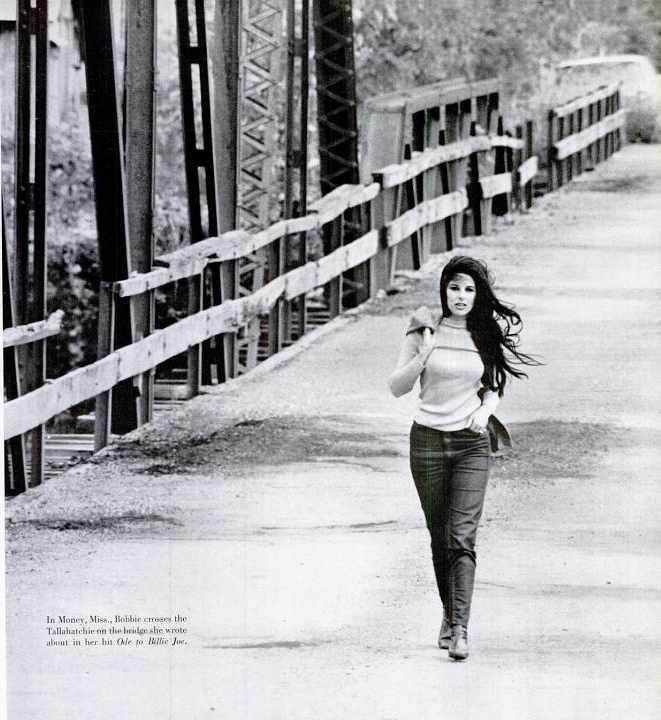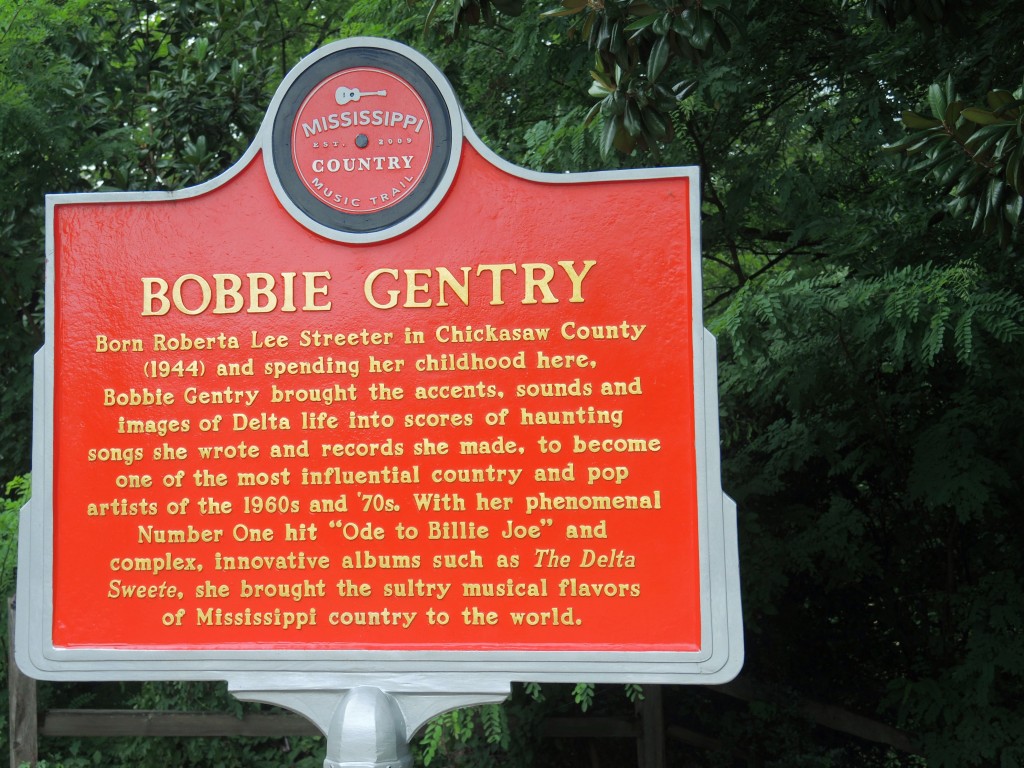From this point, I’d return to the music and the words. If my pre-trip research proved accurate, I knew I shouldn’t have to turn off Money Road to reach my next destination – one of the graves of Robert Johnson. To the uninitiated, the phrase “one of the graves” may seem a bit grotesque and may evoke images of the man being chopped into pieces and buried throughout LeFlore County. The truth isn’t grotesque but it is, like the man, mysterious.
As I noted in my previous post, Johnson burst onto the blues scene in the 1930s, displayed prodigious talent as a singer and guitarist, and died at age 27 essentially a forgotten man. The circumstances surrounding his life and death always remained puzzling and the placement of his body remains equally so. The three sites competing for the right to claim his earthly remains are the Payne Chapel Memorial Baptist Church in Itta Bena (or Quito), Mississippi, the Mount Zion Missionary Baptist Church in Morgan City, and the Little Zion Missionary Baptist Church on Money Road near Greenwood.
I chose the last not merely because it was convenient but because, by all accounts, this seems to be the most likely of the three to be the authentic final resting place of Robert Johnson. In 1990, a stone was placed at Payne Memorial by an Atlanta based band called the Tombstones. The main story that provides the “evidence” that Johnson is buried here comes from another blues musician, David “Honeyboy” Edwards who was allegedly with Johnson when he died and who claims that Johnson’s sister had his remains moved to this site.
Johnson’s death certificate indicates that he was buried at Zion Baptist Church. The Mount Zion site had no marker until 1991 when Columbia Records, which had coincidentally recently released a collection of Johnson’s recordings, erected a large cenotaph that lists all of Johnson’s song titles.
In the end, I acceded to the work of Steven LaVere, a record producer and historian, as providing the strongest evidence that the site I visited at Little Zion is the most likely of the three to be Johnson’s actual grave. LaVere spent decades researching the musician’s life. Among the facts he discovered were that a fellow named Tom Eskridge dug Johnson’s grave in 1938. The source for this information was Eskridge’s widow, Rosie. She remembered walking from the Luther Wade Plantation and bringing water out for her husband to the Little Zion M B Church gravesite on an extremely hot August day. She further recalled her husband digging Johnson’s grave next to a pecan tree at Little Zion Missionary Baptist Church. Her description correlates well with the marked site. Although no marker was laid at the time of the burial, one was placed in that spot at some later time. One additional indicator of this site’s authenticity is that it is the closest of the three to the residence at the Star of the West plantation where Johnson died.
Interestingly, the mystery doesn’t entirely end here. One other rumor is that the original marker was a black granite headstone that has since vanished. The marker in the photo above was placed in 2001.
While the Blues Trail Marker is on the roadside, the grave itself is not near the road. To find it, you need to look for the row of three trees to your left. Walk past the third tree. Look a bit to your right and then you should be able to spot it. Two other notes about this site: the ground can be a bit marshy – more so if it has rained recently – so wear appropriate shoes. Also, walking through the graveyard on a Sunday morning can draw some, shall I say, disapproving stares from congregants who come to the front door of the church. So, be prepared.
As I was tooling along these backroads on a sleepy, dusty, Delta day, I crossed and re-crossed the Tallahatchie River. Thus, I couldn’t help but have this tune running through my head:.
And while some great images of Bobbie Gentry can still be found floating around the internet, this is the one that floated into my mind. This picture ran on the cover of Life Magazine in 1967. I pulled to the side of the road, took out my phone, and started an internet search. The search took me to a site called Bridgehunter where I found there was some considerable dispute regarding the bridge that inspired the song. Two things seemed to be in little doubt, however. The first, is that the bridge in the picture no longer exists. I found two plausible and possible explanations why. One: It collapsed in 1972 and was replaced in 1987 as reported in one source. Two: It was demolished and replaced in that latter year as reported elsewhere. Regardless, both agree that the bridge in the photo is no more. The second item in dispute is that Gentry herself later indicated in at least one interview that she had no specific bridge in mind when she penned the song. In another she said it was a different bridge from the one in the photograph. In fact, three bridges including the bridge that replaced the one above and two others now lay claim to being the “Ode to Billie Joe” Bridge. So, as with Robert Johnson’s gravesite, the Delta presented another dilemma of choosing which of the three to try to find.
This picture ran on the cover of Life Magazine in 1967. I pulled to the side of the road, took out my phone, and started an internet search. The search took me to a site called Bridgehunter where I found there was some considerable dispute regarding the bridge that inspired the song. Two things seemed to be in little doubt, however. The first, is that the bridge in the picture no longer exists. I found two plausible and possible explanations why. One: It collapsed in 1972 and was replaced in 1987 as reported in one source. Two: It was demolished and replaced in that latter year as reported elsewhere. Regardless, both agree that the bridge in the photo is no more. The second item in dispute is that Gentry herself later indicated in at least one interview that she had no specific bridge in mind when she penned the song. In another she said it was a different bridge from the one in the photograph. In fact, three bridges including the bridge that replaced the one above and two others now lay claim to being the “Ode to Billie Joe” Bridge. So, as with Robert Johnson’s gravesite, the Delta presented another dilemma of choosing which of the three to try to find.
One of those bridges does have a marker naming it the bridge that was used in the filming of the movie with the misspelled title (Ode to Billy Joe) that the song inspired. However, after multiple crossings of the Tallahatchie without spotting any sign, I had all but decided to end this search. Another factor in that decision is that while there is also a real Choctaw Ridge in Mississippi, it’s about 90 miles east of all these bridges thus lending substantial credence to the “no specific bridge” theory. As luck would have it, while my GPS was leading me hither and thither around the Delta looking for the road to take me to Oxford, I found myself crossing a bridge over the Tallahatchie into the town of Greenwood. A red marker caught the periphery of my vision. I stopped the car and walked to it.¬† Right or wrong, this would be my Tallahatchie bridge. With a tiny burden lifted, I drove on to Oxford.
Right or wrong, this would be my Tallahatchie bridge. With a tiny burden lifted, I drove on to Oxford.